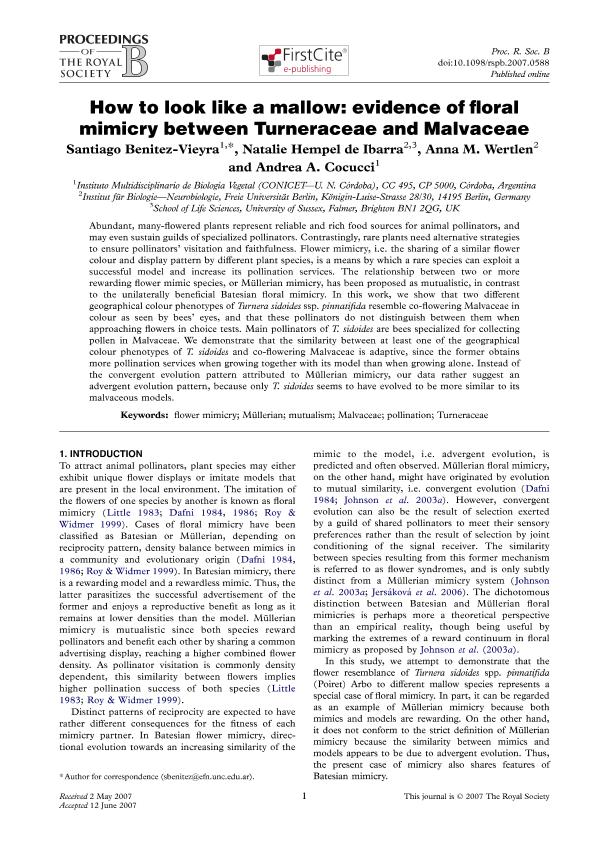Mostrar el registro sencillo del ítem
dc.contributor.author
Benitez-Vieyra, Santiago Miguel

dc.contributor.author
Hempel de Ibarra, Natalie
dc.contributor.author
Wertlen, Anna M.
dc.contributor.author
Cocucci, Andrea Aristides

dc.date.available
2018-04-09T13:55:45Z
dc.date.issued
2007-09
dc.identifier.citation
Benitez-Vieyra, Santiago Miguel; Hempel de Ibarra, Natalie; Wertlen, Anna M.; Cocucci, Andrea Aristides; How to look like a mallow: evidence of floral mimicry between Turneraceae and Malvaceae; The Royal Society; Proceedings of the Royal Society of London. Series B: Biological Sciences; 274; 1623; 9-2007; 2239-2248
dc.identifier.issn
0962-8452
dc.identifier.uri
http://hdl.handle.net/11336/41285
dc.description.abstract
Abundant, many-flowered plants represent reliable and rich food sources for animal pollinators, and may even sustain guilds of specialized pollinators. Contrastingly, rare plants need alternative strategies to ensure pollinators’ visitation and faithfulness. Flower mimicry, i.e. the sharing of a similar flower colour and display pattern by different plant species, is a means by which a rare species can exploit a successful model and increase its pollination services. The relationship between two or more
rewarding flower mimic species, or Mullerian mimicry, has been proposed as mutualistic, in contrast to the unilaterally beneficial Batesian floral mimicry. In this work, we show that two different geographical colour phenotypes of Turnera sidoides ssp. pinnatifida resemble co-flowering Malvaceae in colour as seen by bees’ eyes, and that these pollinators do not distinguish between them when approaching flowers in choice tests. Main pollinators of T. sidoides are bees specialized for collecting pollen in Malvaceae. We demonstrate that the similarity between at least one of the geographical colour phenotypes of T. sidoides and co-flowering Malvaceae is adaptive, since the former obtains more pollination services when growing together with its model than when growing alone. Instead of the convergent evolution pattern attributed to Müllerian mimicry, our data rather suggest an advergent evolution pattern, because only T. sidoides seems to have evolved to be more similar to its malvaceous models.
dc.format
application/pdf
dc.language.iso
eng
dc.publisher
The Royal Society

dc.rights
info:eu-repo/semantics/openAccess
dc.rights.uri
https://creativecommons.org/licenses/by-nc-sa/2.5/ar/
dc.subject
Flower Mimicry
dc.subject
Mutualism
dc.subject
Malvaceae
dc.subject.classification
Otras Ciencias Biológicas

dc.subject.classification
Ciencias Biológicas

dc.subject.classification
CIENCIAS NATURALES Y EXACTAS

dc.title
How to look like a mallow: evidence of floral mimicry between Turneraceae and Malvaceae
dc.type
info:eu-repo/semantics/article
dc.type
info:ar-repo/semantics/artículo
dc.type
info:eu-repo/semantics/publishedVersion
dc.date.updated
2018-04-03T19:22:51Z
dc.identifier.eissn
1471-2954
dc.journal.volume
274
dc.journal.number
1623
dc.journal.pagination
2239-2248
dc.journal.pais
Reino Unido

dc.journal.ciudad
Londres
dc.description.fil
Fil: Benitez-Vieyra, Santiago Miguel. Consejo Nacional de Investigaciones Científicas y Técnicas. Centro Científico Tecnológico Conicet - Córdoba. Instituto Multidisciplinario de Biología Vegetal. Universidad Nacional de Córdoba. Facultad de Ciencias Exactas Físicas y Naturales. Instituto Multidisciplinario de Biología Vegetal; Argentina
dc.description.fil
Fil: Hempel de Ibarra, Natalie. Universität zu Berlin; Alemania. University of Sussex; Reino Unido
dc.description.fil
Fil: Wertlen, Anna M.. Universität zu Berlin; Alemania
dc.description.fil
Fil: Cocucci, Andrea Aristides. Consejo Nacional de Investigaciones Científicas y Técnicas. Centro Científico Tecnológico Conicet - Córdoba. Instituto Multidisciplinario de Biología Vegetal. Universidad Nacional de Córdoba. Facultad de Ciencias Exactas Físicas y Naturales. Instituto Multidisciplinario de Biología Vegetal; Argentina
dc.journal.title
Proceedings of the Royal Society of London. Series B: Biological Sciences

dc.relation.alternativeid
info:eu-repo/semantics/altIdentifier/url/http://rspb.royalsocietypublishing.org/content/274/1623/2239
dc.relation.alternativeid
info:eu-repo/semantics/altIdentifier/doi/http://dx.doi.org/10.1098/rspb.2007.0588
Archivos asociados
